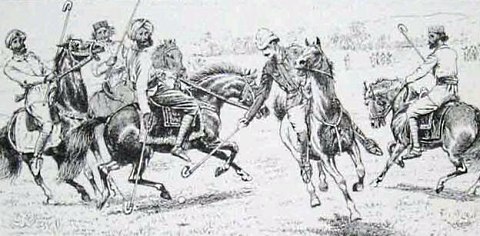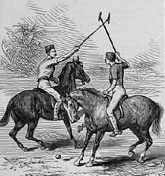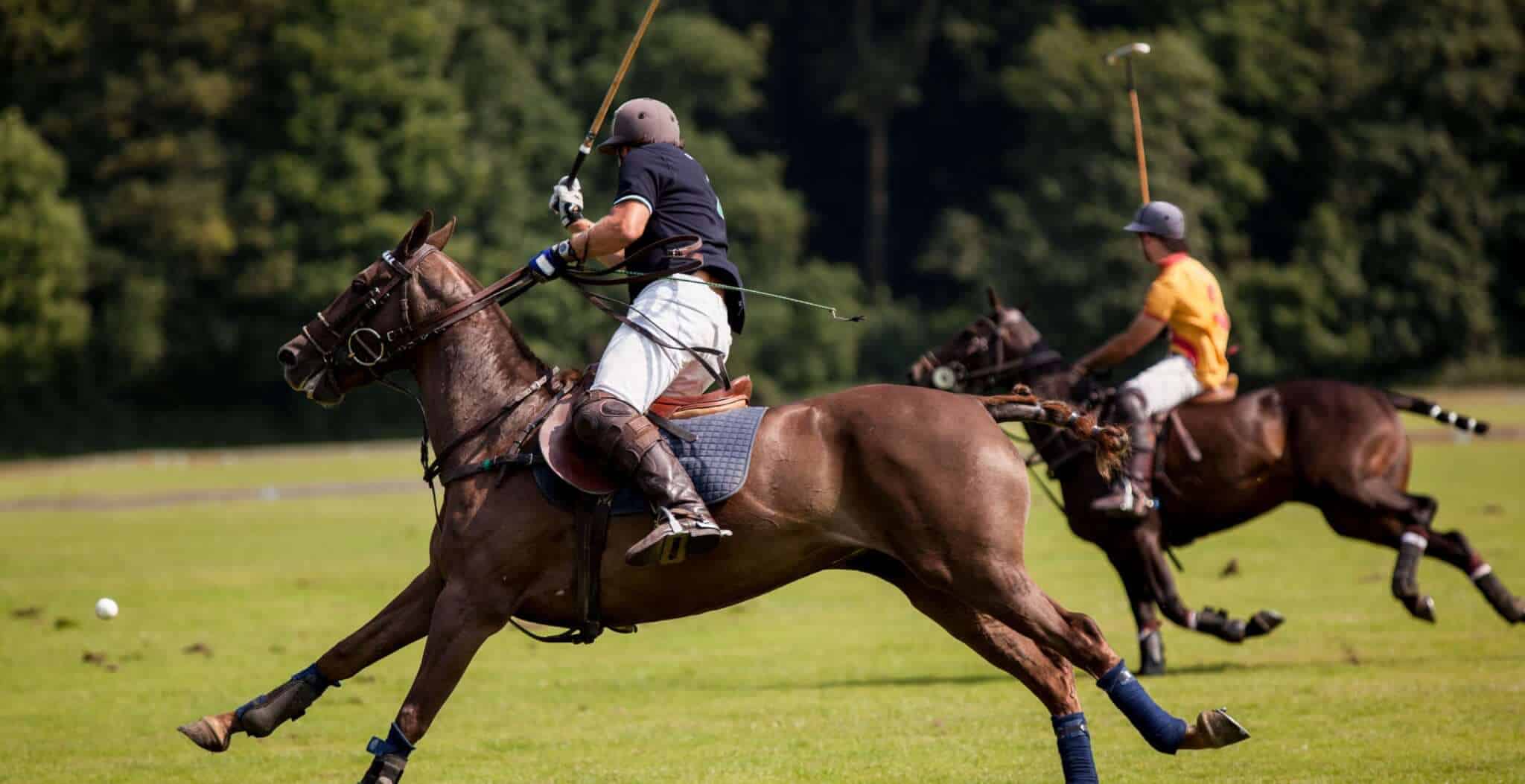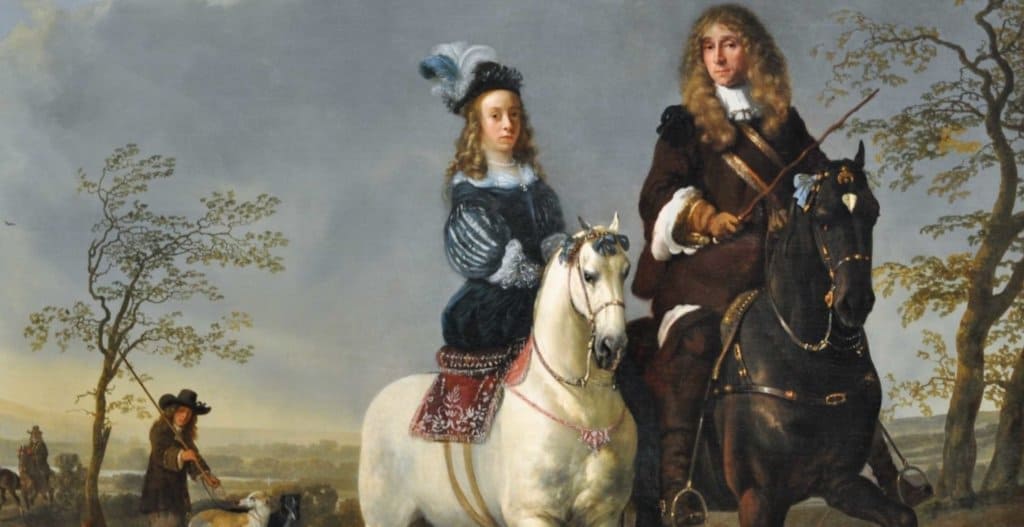Polo is perhaps the oldest team sport, although the exact origins of the game are unknown. It was probably first played by nomadic warriors over two thousand years ago but the first recorded tournament was in 600 B.C. (between the Turkomans and the Persians – the Turkomans were victorious). The name is supposed to have originated from the Tibetan “pholo” meaning “ball” or “ballgame”. It is since these origins in Persia that the game has often been associated with the rich and noble of society; the game was played by Kings, Princes and Queens in Persia. Polo has also been linked to the middle and upper classes in the more recent British past, especially with its origins in Britain being with the militia. This is also perhaps due to it being, as a game played on horseback and requiring at least two horses per game, an expensive hobby to maintain.
Played on horse back, in the Middle Ages it was used in the training of cavalry across the East (from Japan to Constantinople, and was played almost as a miniature battle. It first became known to western peoples via British tea-planters in Manipur (between Burma and India) and it spread to Malta with soldiers and naval officers. In 1869, the first game in Britain (of “hockey on horseback” as it was referred to at first) was organised on Hounslow Heath by officers stationed at Aldershot, one of whom had read about the game in a magazine.

The first official written rules (on which the present international rules are based) were not created until the 19th Century by Irishman Captain John Watson of the British Cavalry 13th Hussars. These were revised in 1874 to create the Hurlingham Rules, restricting the number of players on each team.
However, the size of the Polo pitch (nearly 10 acres in area, slightly more than nine football pitches; the largest field in organised sport!) has not altered since one of the first pitches was built, in front of Ali Ghapu Palace in the ancient city of Ispahan (Isfahan, Iran) in the 1500’s. Today it is used as a public park and the original stone goal posts remain. In addition to the vast pitch, an area called the “run off area” is used; incidents within the game that occur within this area are considered as if they happened within the confines of the actual pitch!
Rules
When played on an open field, each team has 4 players on horseback but when the game is restricted to an enclosed stadium, 3 players take part on each team. There is no “season” for Polo unlike other sports such as football or cricket, due to the ability for it to be played indoors as well as out. A new variation on the game is “snow polo”, completely unrestricted by “bad” weather patterns! Only three players on each team here and the equipment is altered to suit the conditions. It is, however, considered separate from the traditional polo game due to these differences.
 A full game of Polo consists of 4, 6 or 8 “chukkas”. Each chukka involves seven minutes of play, after which a bell is rung and play continues for either another 30 seconds or until the ball (now, a white plastic or wooden ball, originally made of willow) goes out of play. The chukka is ended where the ball finishes. A three minute break is given between each chukka and a five minute break at half time. Between each chukka, each player will dismount and change ponies (the term “polo pony” is traditional but the animals are usually of horse proportions). Sometimes a fresh pony will be ridden in each chukka or two ponies will be on rotation, but ponies will not usually play more than two chukkas. Ends are changed after each goal is scored. The game and the chukkas may seem relatively short to you and Polo is the fastest ball game in the world, but not in terms of the length of each match. The fact that the players are mounted on horseback allows high speeds to be reached and ensures fast paced passing of the ball between players. However, the Hurlingham rules, the background to the game played in Britain, allow a more sedate and methodical pace; how typically British!
A full game of Polo consists of 4, 6 or 8 “chukkas”. Each chukka involves seven minutes of play, after which a bell is rung and play continues for either another 30 seconds or until the ball (now, a white plastic or wooden ball, originally made of willow) goes out of play. The chukka is ended where the ball finishes. A three minute break is given between each chukka and a five minute break at half time. Between each chukka, each player will dismount and change ponies (the term “polo pony” is traditional but the animals are usually of horse proportions). Sometimes a fresh pony will be ridden in each chukka or two ponies will be on rotation, but ponies will not usually play more than two chukkas. Ends are changed after each goal is scored. The game and the chukkas may seem relatively short to you and Polo is the fastest ball game in the world, but not in terms of the length of each match. The fact that the players are mounted on horseback allows high speeds to be reached and ensures fast paced passing of the ball between players. However, the Hurlingham rules, the background to the game played in Britain, allow a more sedate and methodical pace; how typically British!
The ball is hit with a stick or mallet, rather like a lengthened version of the stick used in croquet, wielded by each mounted player towards the goals at each end. In the games played in Manipur centuries ago, players were allowed to carry the ball with them on their horses which often lead to physical fights between players to gain the ball for their teams. The game is played right handed (there are only three players on the international circuit who are left handed); for safety reasons, in 1975, left handed play was prohibited.
After the mechanisation of the cavalry, where perhaps the most enthusiasm was built for the game, its popularity declined. But! There was a revival during the 1940’s and today, more than 77 countries play Polo. It was a recognised Olympic sport between 1900 and 1939 and is now, again, acknowledged by the International Olympic Committee.
Published: 26th June 2015



